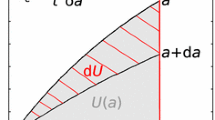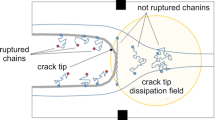Abstract
This study demonstrates through experimental validation, that one can predict critical loads of arbitrarily shaped cracked rubber specimens of the mixed-mode type (mode I and II) using a plane stress finite element method and utilizing material constants that characterize the mechanical and fracture properties of SBR (Styrene Butadiene Rubber) material determined from experimental tests on a mode I specimen. Conversely, the finite element method can be used to extract useful critical tearing energy information from complicated, arbitrarily shaped cracked rubber specimens. The predicted critical loads or critical tearing energies for crack growth initiation and final fracture, as well as the crack growth initiation direction are compared to the experimental data with good agreement.
Similar content being viewed by others
References
R.S. Rivlin and A.G. Thomas,Journal of Polymer Science 10 (1953) 291–318.
G.J. Lake and A.G. Thomas,Proceedings, Royal Society, London, A300 (1967) 108–119.
A.G. Thomas,Journal of Polymer Science 31 (1958) 467.
H.W. Greensmith,Journal of Polymer Science 7 (1963) 993–1002.
G.J. Lake and P.B. Lindley,Journal of Applied Polymer Science 9 (1965) 1233–1251.
J.R. Rice,Journal of Applied Mechanics 35 (1968) 379–386.
D.J. Lee and J.A. Donovan,Theoretical and Applied Fracture Mechanics 4 (1985) 137–147.
N.M. Wang,International Journal of Solids and Structures 9 (1973) 1211–1223.
N.M. Wang and J.L. Oh,Fracture 1977 3 (1977) 467–484.
D.J. Lee and J.A. Donovan,International Journal of Fracture 34 (1987) 41–55.
A.E. Green and J.E. Adkins,Large Elastic Deformations and Non-linear Continuum Mechanics, Oxford (1960).
T.K. Hellen in International Conference on -Structural Mechanics in Reactor Technology (Smirt), Berlin (1973) paper 65/3.
D.M. Parks,International Journal of Fracture 10 (1974) 487–501.
D.M. Parks,Computer Methods Applied Mechanics and Engineering (1977) 353–364.
R.B. Haber and H.M. Koh,International Journal for Numerical Methods in Engineering 21 (1985) 301–315.
R.M.V. Pidaparti, T.Y. Yang and W. Soedel,International Journal of Fracture 39 (1989) 255–268.
F. Erdogan and G.C. Sih,Journal of Basic Engineering 50D (1963) 519–525.
G.C. Sib,International Journal of Fracture 10 (1974) 305–321.
L.R.G. Treloar,The Physics of Rubber Elasticity, 3rd ed., Clarendon Press, Oxford (1975) Chapter 11.
C.L. Chow, J. Wang and P.N. Tse,Tire Science and Technology 16, No. 1 (1988) 44–60.
M.A. Hussain, S.L. Pu and J.M. Underwood, inFracture Analysis, ASTM STP 560 (1974) 2–28.
J.A. Begley and J.D. Landes, inFracture Toughness, ASTM STP 514 (1972) 1–20.
R.W. Ogden,Proceedings of Royal Society, London, series A 326 (1972) 565–584.
E. Dragonia and G. Medri,Theoretical and Applied Fracture Mechanics 10 (1988) 79–83.
Author information
Authors and Affiliations
Rights and permissions
About this article
Cite this article
Pidaparti, R.M.V., Yang, T.Y. & Soedel, W. Plane stress finite element prediction of mixed-mode rubber fracture and experimental verification. Int J Fract 45, 221–241 (1990). https://doi.org/10.1007/BF00693350
Received:
Accepted:
Issue Date:
DOI: https://doi.org/10.1007/BF00693350




